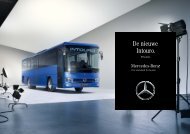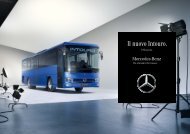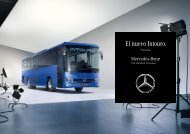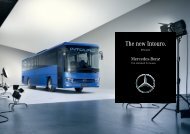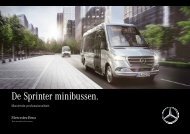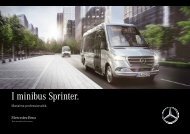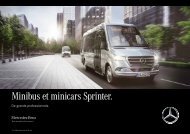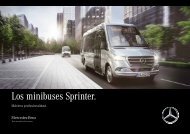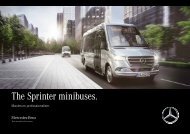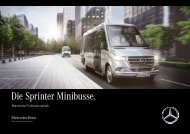S-CC500-1-EN-0819
Create successful ePaper yourself
Turn your PDF publications into a flip-book with our unique Google optimized e-Paper software.
Technology in detail. Things to know about the important features<br />
and options of the ComfortClass 500.<br />
ART 107 SPA 109<br />
Kneeling 112 Variante 01 FCG 114 AquaBlade 115 ESP 106<br />
Sideguard Assist.<br />
The Sideguard Assist turning assistant feature considerably<br />
increases the safety of unprotected road users, especially<br />
in cities, since it helps the driver recognise critical situations<br />
in a timely manner when turning. The system operates in<br />
different stages: in a first stage, it informs the driver, and in<br />
a second stage, it provides an additional warning.<br />
If a moving object is located in the lateral or side monitoring<br />
zone, the driver is informed optically. In the exterior<br />
mirror on the passenger’s side, an LED light in a triangular<br />
shape illuminates yellow at the driver’s height of vision.<br />
It intuitively directs the attention to the situation next to<br />
the vehicle. Additionally, a warning message appears in<br />
the central display.<br />
If the driver initiates or continues an action that could lead<br />
to a collision, an additional visual warning is given: the LED<br />
light flashes several times red with higher luminosity and<br />
then permanently. In addition to this, a tactile vibration<br />
acts as a warning in the driver’s seat. Moreover, Sideguard<br />
Assist warns the driver of stationary obstacles in the<br />
coach’s turning curve and can also take on the task of<br />
a lane changing assistant, in which case it operates with<br />
the same warning cascade.<br />
Active Brake Assist 4 (ABA 4).<br />
Regardless of the Adaptive Cruise Control (ART) function,<br />
Active Brake Assist 4 (ABA 4) warns the driver prior to<br />
a collision with an obstacle and independently brakes the<br />
coach. To this end, the radar-controlled system constantly<br />
scans an area of up to 250 metres of the lane in front of the<br />
coach. As the worldʼs first system of its kind, ABA 4 also<br />
reacts to pedestrians.<br />
Therefore, in addition to moving vehicles and stationary<br />
obstacles ahead (e.g. the tail-end of a traffic jam), the system<br />
also detects pedestrians within 80 metres. For example,<br />
should the distance to pedestrians be dangerously reduced,<br />
the system alerts the driver by means of visual and acoustic<br />
warning signals, while initiating partial braking through to a<br />
standstill if the driver does not respond. The partial braking<br />
provides the driver with the possibility of avoiding the collision<br />
by means of a full braking or steering manoeuvre. Additionally,<br />
he can warn endangered pedestrians in time using the<br />
vehicle’s horn.<br />
Adaptive Cruise Control (ART).<br />
The Adaptive Cruise Control feature relieves the driver by<br />
maintaining a constant distance – defined by the driver –<br />
from the vehicle ahead, based on continuous measurements.<br />
This not only increases safety on country roads and<br />
highways, but also convenience.<br />
A radar system, which guarantees outstanding functionality<br />
even under poor weather conditions and in the dark, monitors<br />
a distance of up to 250 meters in front of the vehicle and to<br />
the full width of the road. Should a variably defined security<br />
distance to the vehicle driving ahead be undercut, ART slows<br />
down the coach so that the safety zone is maintained. Many<br />
rear-impact collisions can therefore be avoided.<br />
Unlike the emergency assistant Active Brake Assist 4<br />
(ABA 4), ART initiates a smooth braking with maximum<br />
20 per cent of its possible power.<br />
Lane Assist (SPA).<br />
Driver fatigue ranks among the most frequent causes of<br />
accidents. The Lane Assist feature, at the heart of which<br />
is a camera positioned behind the front windscreen,<br />
continuously measures the lateral distance to side road<br />
markings. If the driver leaves his lane, the system warns<br />
him using a directional vibration in the seat cushion. For<br />
example, if he inadvertently heads to the right, the seat<br />
cushion vibrates on the right side.<br />
To avoid false alarms, the Lane Assist is only activated at<br />
speeds of 60 km/h or above. This prevents problems<br />
along construction sites, where coaches hardly drive at<br />
speeds greater than 60 km/h. If the driver consciously<br />
changes lanes and puts the blinker on, the Lane Assist<br />
recognises this and does not give a warning.<br />
Level lowering and kneeling.<br />
The ComfortClass 500 is equipped with an electronic level<br />
control which offers tangible benefits to both operators<br />
and passengers. On the one hand, at high speeds, the level<br />
of the coach is automatically lowered, which in interaction<br />
with the very aerodynamic design of the ComfortClass 500,<br />
contributes to optimised fuel consumption. On the other<br />
hand, for the first time with a coach, “kneeling” is used as<br />
standard equipment. This allows the level of the non-moving<br />
coach to be lowered on one side, to facilitate passenger<br />
entry into the coach.<br />
Front Collision Guard (FCG).<br />
In the case of a frontal collision, the Front Collision Guard<br />
(FCG) offers increased safety in the front part of the vehicle<br />
and reliable underride protection through a cross profile.<br />
Crash elements, with an absorber structure which transforms<br />
impact energy into distortion energy, are positioned behind<br />
the FCG’s cross profile. This considerably reduces the outcome<br />
of the impact.<br />
Since the driver’s work space, incl. steering, pedals and seat,<br />
is mounted on a massive frame component, it can be pushed<br />
backwards to maintain a protective space for the driver in the<br />
case of severe frontal impact. So, the interplay of Active<br />
Brake Assist 4 (ABA 4) and FCG can achieve unparalleled<br />
levels of safety for the driver and attendant, and ultimately<br />
for passengers as well.<br />
The FCG fulfils the requirements of the underride guard<br />
according to ECE-R 93, as well as legal norms for pendulum<br />
impact in coaches.<br />
The AquaBlade windshield washer system.<br />
With a highly innovative profile, the AquaBlade flat-blade<br />
wipers ensure that the cleaning water is distributed<br />
very evenly on the windscreen. What is unusual about the<br />
system is that the cleaning water exits the wiper blade<br />
and is immediately directly to the area requiring cleaning.<br />
This enhances comfort, saves cleaning water, enables<br />
improved cleaning and optimised visibility – and ultimately<br />
a significant plus in safety. As well, the AquaBlade flatblade<br />
wipers feature exceptional aerodynamic qualities,<br />
which also result in reduced noise.<br />
Electronic Stability Programme (ESP ® ).<br />
The Electronic Stability Programme (ESP ® ) significantly<br />
reduces the risk of skidding, by counteracting the vehicle’s<br />
swerving through targeted braking of individual wheels.<br />
High-performance electronics monitor the signals of<br />
ESP ® sensors and continuously check whether the driver’s<br />
steering intention and the actual motion of the vehicle<br />
correspond. If the values differ, the system instantly reduces<br />
the engine power to re-establish the vehicle’s balance and<br />
stability. If this is not sufficient, the system additionally<br />
brakes individual wheels.<br />
Two further active safety systems are included in the<br />
ESP ® system: the Anti-lock Braking System (ABS) and the<br />
Integrated Traction Control (ASR).<br />
28<br />
29



